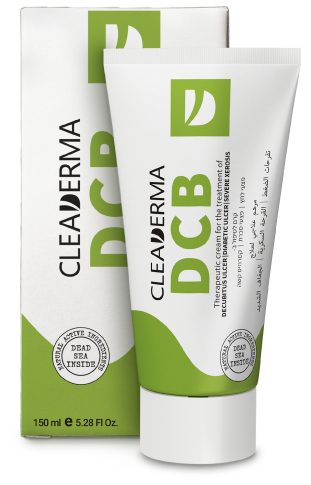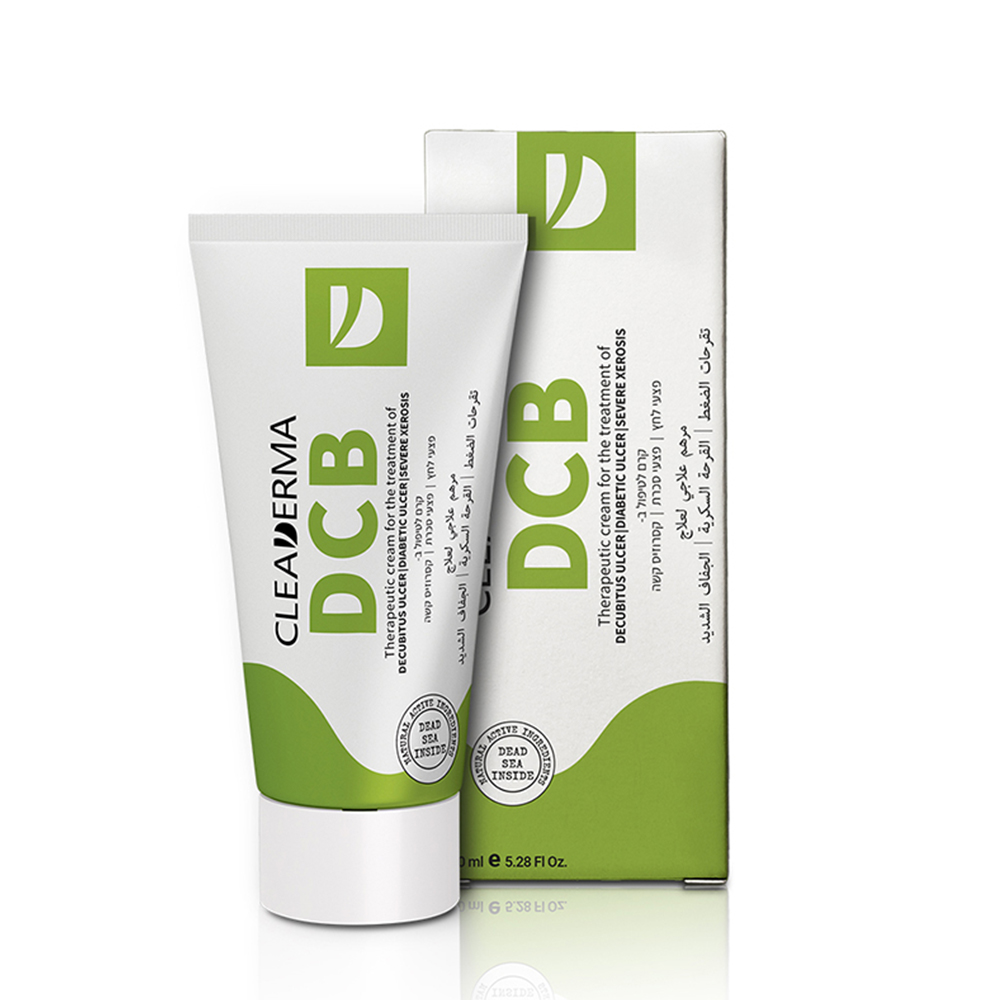
Ease Their
SUFFERING.
A Medical Device ointment for the treatment of pressure ulcers
(Bed Sores), Vascular Ulcers, Diabetic Ulcers, and Severe Xerosis.
A world-leading preventative treatment for Pressure/Vascular Ulcers.
EASE THEIR
SUFFERING.
A Medical Device ointment for the treatment of pressure ulcers (Bed Sores), Vascular Ulcers, Diabetic Ulcers, and Severe Xerosis.
A world-leading preventative treatment for Pressure/Vascular Ulcers.
Choose type of ulcer you would like to treat
WE WILL EASE THEIR SUFFERING.
CleaDerma DCB Ointment will heal your loved one's ulcers, ease their pain, prevent reoccurrence of the ulcers and ease the burden on you and your family.
HOW DOES IT WORK?
CleaDerma DCB ointment serves as a physiological buffer to assist in the case of pressure ulcers, diabetic ulcers, venous ulcers, and extremely dry xerosis. It promotes the natural healing of dry, damaged, irritated skin. DCB CleaDerma ointment is enriched with Dead Sea Minerals, natural oils, and natural plant extracts that revitalize, rejuvenate, moisturize, and nourish the skin cells and return them to their natural elasticized state.

CleaDerma DCB Ointment
If you have a family member bed ridden or confined to a wheelchair or suffering from vascular/arterial disease or diabetic, they are prone to develop life risking ulcers, you must be ready to ease their suffering you must have CleaDerma DCB at hand, to treat and prevent the ulcers.
BUY MORE, SAVE MORE
Heavy moisture and nourishment
Keeping the skin strong and elastic allows it to better defend against breakage and the formation or reoccurrence of ulcers.
Rapid pain reduction
Ulcers accompany pain, causing suffering and extreme discomfort to our loved ones. The plant extracts in the CleaDerma DCB alleviate the pain relaxing the patient and allowing the ointment to do its job with as little to no discomfort.
Enhances Skin's Natural Healing Process
When the skin rebuilds itself in its natural process, it is strong, elastic, and more resilient than when forced healing occurs. The skin is thinner ad tends to break easily.
Constant Use Prevents Ulcers Reoccurrence
stage where they are small and easy to treat, so applying CleaDerma DCB to areas prone to develop pressure ulcers or vascular ulcers on a regular basis prevents the ulcer from developing by keeping the skin strong and elastic.
Case Study Gallery
Articles And Studies
Severe xerosis, or dry skin, can be a difficult condition to manage. If left untreated, xerosis can lead to cracked and bleeding skin, hyperkeratosis, and infection.
Millions of Americans live with diabetes, a chronic condition that can cause serious health problems if not properly managed. One complication associated with diabetes is the development of diabetic ulcers.
Calendula is widely used due to its strong healing qualities. By using the calendula flower on various cuts, bruises, burns, scrapes, and insect bites, you can help your body speed up its natural healing process.
30 Days money back guarantee
100% Natural (botanical) active ingredients
Not tested on animals
Steroid Free
What Our Patients Say
FAQ
Frequently Asked Questions
The product is suitable for children ages 10 and up, as well as for adults.
For pregnant women – check the list of ingredients and if there is a known sensitivity to one of them during pregnancy, the use of the product should be avoided.
The product should be stored in a cool and dry place away from heat or exposure to direct sunlight.
The product should not be stored at a temperature exceeding 30C.
The product should not be used after the expiration date or the time period from the opening date specified on the product.
Please note that CleaDerma DCB does not replace wound care protocol. This is an additional treatment.
Note: if the patient is immobile, please adhere to all the needed procedures to improve blood circulation (It is essential to keep the patient’s skin dry and clean, use an Anti-decubitus mattress, turn the patient from one side to another every few hours, perform a set of physical exercise daily).
Wash your hands before and after treating the wound. Use gloves at all times
Stages 1-2 of pressure ulcer treatment:
Before using the CleaDerma DCB ointment, carefully clean the wound with saline and dry the wound.
The pressure ulcer and the area around it are in dire need of moisture, nutrition, and oxygen, so you must apply enough ointment to cover the area and skin around it, massaging gently until the area is evenly covered; no need to rub it. Not necessary to bandage. Use ointment two to three times a day and clean once a day before the first application until the skin improves as directed by a doctor.
Remember:
Always ensure that the wound and surrounding area are clean, with no extra moisture, urine, and feces remaining.
Stage 3 of treating a pressure ulcer:
Note: cleaning and debridement of stage 3 Pressure Ulcers should be done by a professional caregiver whenever possible.
Before using the CleaDerma DCB ointment, carefully clean the wound with saline. Ensure that the wound and surrounding area are clean, with no extra moisture, urine, and feces remaining.
Apply enough ointment to cover the area and skin around, massaging gently until the area is evenly covered; no need to rub it.
The dressing or patch should be larger than the wound and the area around it so that the sticky surface sticks to healthy skin.
If a gauze should be applied directly on top of the wound, put a thin layer of CleaDerma DCB ointment on it and then lay on the wound and cover it with a clean bandage.
Note: it is recommended for stage 3 pressure ulcers to reapply twice a day until the skin improves, as directed by a doctor.
Remember:
Always ensure that the wound and surrounding area are clean, with no extra moisture, urine, and feces remaining.
Stage 4 of treating a pressure ulcer:
Note: cleaning and debridement of stage 4 Pressure Ulcers must be done according to the treatment protocol assigned by the doctor or a professional caregiver.
Before using the CleaDerma DCB ointment, carefully clean the wound with saline. Ensure that the wound and surrounding area are clean, with no extra moisture, urine, and feces remaining.
CleaDerma DCB ointment must be applied to the internal walls of the wound and the skin around it.
Note: Do not fill the wound with ointment.
If a gauze should be applied directly on top of the wound, put a thin layer of CleaDerma DCB ointment on it and then lay on the wound and cover it with a clean bandage.
Note: dressing of stage 4 Pressure Ulcers must be done according to the treatment protocol assigned by the doctor or a professional caregiver.
If the dressing should be replaced every 24 hours, apply a more significant amount of ointment to the wound and skin around it. If possible, apply CleaDerma DCB ointment twice a day until the skin improves, as directed by a doctor.
Preventative treatment of pressure ulcers:
Body areas with pressure wound stage 1 to 4 that have been treated and healed or body areas prone to develop a pressure wound have fragile skin. Although still not showing signs of a pressure wound, the skin is already suffering from deprivation of oxygen, moisture, and nourishment, causing it to dehydrate and lose its elasticity and capability to rejuvenate itself, so by applying unique, specialized atopic ointment CleaDerma DCB to those areas you supply most of the missing materials the skin needs to better fight the development of a pressure wound .
Note: It is recommended to apply a CleaDerma DCB ointment to all areas prone to develop pressure ulcers (Here are the most common: on bony parts of the body, such as the heels, elbows, hips, and base of the spine).
It is essential to remember!
Despite using CleaDerma DCB, the patient should be rotated from side to side every two hours to release the pressure from the wound and surrounding area
Please note that CleaDerma DCB does not replace wound care protocol. This is an additional treatment.
Wash your hands before and after treating the wound. Use gloves at all times.
Stages 1-2 of diabetic foot ulcer treatment:
Before using the CleaDerma DCB ointment, carefully clean the wound with saline and dry the wound and surrounding area (no rubbing, just tapping).
stages 1 (normal skin)-2 (in high risk of developing a wound).
It is recommended to apply CleaDerma DCB ointment to all areas prone to develop a diabetic foot ulcer and on the surrounding area, especially before any physical exercises.
Massage gently until maximum absorption. Not necessary to bandage. Use ointment two to three times a day and clean once a day before the first application.
Remember: Always ensure that the skin/wound and surrounding area are clean, with no extra moisture.
Stage 3 of diabetic foot ulcer:
Note: It is extremely important to examine your feet daily to see if there are any skin lesions or ulcerations. Diabetes can prevent you from feeling any sensations if these things happen. That is why it is necessary to check every day.
Before using the CleaDerma DCB ointment, carefully clean the wound with saline. Ensure that the wound and surrounding area are clean, with no extra moisture.
In stage 3, we can see the appearance of ulceration on your foot. Here we must act in the following manner:
- Carefully clean the wound and surrounding area with saline
- Make sure that no debris is stuck into the ulceration.
- Apply a generous amount of The CleaDerma DCB to the ulceration and surrounding area, massaging gently until the area is evenly covered; no need to rub it.
- Apply a wound dressing. It is recommended for stage 3 diabetic foot ulcers to reapply twice a day until the skin improves, as directed by your doctor.
Note: The dressing or patch should be larger than the wound and the area around it so that the sticky surface sticks to healthy skin.
If a gauze should be applied directly on top of the wound, apply a thin layer of CleaDerma DCB ointment on it and then lay on the wound and cover it with a clean appropriate bandage.
Remember: Always ensure that the wound and surrounding area are clean, with no extra moisture.
Stages 4-5 of diabetic foot ulcer:
Note: cleaning and debridement of stage 4 Diabetic Foot Ulcers must be done according to the treatment protocol assigned by the doctor or a professional caregiver.
Very important to ask a doctor if any antibiotics need to be used alongside the CleaDerma DCB.
Before using the CleaDerma DCB ointment, carefully clean the wound with saline. Ensure that the wound and surrounding area are clean, with no extra moisture.
CleaDerma DCB ointment must be applied to the internal walls of the wound and the skin around it.
Please don’t fill the wound with ointment.
If gauze should be applied directly on top of the wound, apply a thin layer of CleaDerma DCB ointment on it and then lay on the wound and cover it with a clean appropriate bandage.
Important: apply the CleaDerma DCB ointment to the whole foot to maintain healthy, strong, elasticized skin.
Note: dressing of stages 4-5 Diabetic foot Ulcers must be done according to the treatment protocol assigned by the doctor or a professional caregiver.
If the dressing should be replaced every 24 hours, apply a more significant amount of ointment to the wound and skin around it. If possible, apply CleaDerma DCB ointment twice a day until the skin improves, as directed by a doctor.
Please note that CleaDerma DCB does not replace wound care protocol. This is an additional treatment.
Wash your hands before and after treating the wound. Use gloves at all times
Preventative treatment of venous ulcers:
Prior to stage 1 and stage 2 venous ulcers, when the doctor recommends using compression stockings or bandages, which are designed to squeeze your legs and encourage blood to flow upwards toward your heart. It is essential to keep the skin of your lower legs well moisturized. Apply specialized atopic ointment CleaDerma DCB to areas prone to developing venous ulcers. In this case, you will moisturize, nourish, and supply the skin with most of the missing materials deprived from the skin due to poor blood circulation and needed to better cope with developing a venous wound.
Note: It is recommended to apply CleaDerma DCB ointment to all areas prone to develop venous ulcers (Most venous ulcers occur on the leg).
Stages 1-2 of pressure ulcer treatment:
Before using the CleaDerma DCB ointment, carefully clean the wound with saline and dry the wound.
Apply enough ointment to cover the wound area and skin surrounding it, massaging gently until the area is evenly covered; no need to rub it. Apply an appropriate dressing. This provides the best conditions for the ulcer to heal. The compression stockings or bandages are designed to squeeze your legs and encourage blood to flow upwards toward your heart.
Use ointment two to three times a day and clean once a day before the first application until the skin improves as directed by a doctor.
Remember:
Always ensure that the wound and surrounding area are clean, with no extra moisture.
Stage 3 of treating a pressure ulcer:
Note: cleaning and debridement of stage 3 Venous Ulcers should be done by a professional caregiver whenever possible.
Before using the CleaDerma DCB ointment, carefully clean the wound with saline. Ensure that the wound and surrounding area are clean and dry. Try not to get healthy tissue around the wound too wet. This can soften the healthy tissue, causing the wound to get bigger.
Apply enough ointment to cover the area and skin around, massaging gently until the area is evenly covered; no need to rub it.
Important: wear your compression bandage precisely as instructed. If you have any problems, it’s usually best to contact your caregiver.
If a gauze should be applied directly on top of the wound, put a thin layer of CleaDerma DCB ointment on it and then lay on the wound and cover it with a clean bandage.
Note: it is recommended for stage 3 venous ulcers to reapply twice a day until the skin improves, as directed by a doctor.
Remember:
Always ensure that the wound and surrounding area are clean, with no extra moisture.
Stage 4 of treating a venous ulcer:
Note: cleaning and debridement of stage 4 Venous Ulcers must be done according to the treatment protocol assigned by the doctor or a professional caregiver.
Before using the CleaDerma DCB ointment, carefully clean the wound with saline. Ensure that the wound and surrounding area are clean, with no extra moisture.
CleaDerma DCB ointment must be applied to the internal walls of the wound and the skin around it.
Note: Do not fill the wound with ointment.
If a gauze should be applied directly on top of the wound, put a thin layer of CleaDerma DCB ointment on it and then lay on the wound and cover it with a clean bandage.
Note: dressing of stage 4 Venous Ulcers must be done according to the treatment protocol assigned by the doctor or a professional caregiver.
If the dressing should be replaced every 24 hours, apply a more significant amount of ointment to the wound and skin around it. If possible, apply CleaDerma DCB ointment twice a day until the skin improves, as directed by a doctor.
Note: periodical test by the doctor is recommended.
Xerosis cutis most commonly occurs on the arms and legs. Symptoms include dry, itchy, and scaly skin with white flakes. The skin may appear red and irritated, and fine cracks may develop. Your skin may also feel tight, especially after showering or bathing.
Thoroughly clean and dry your skin before using CleaDerma DCB ointment.
Use CleaDerma DCB ointment two to three times a day and cleanse the skin once a day before the first application until the skin improves, as directed by your doctor.
Yes, with CleaDerma DCB ointment, you can prevent pressure ulcers!
Body areas with pressure wound stage 1 to 4 that has been treated and healed or body areas prone to develop a pressure wound have fragile skin. Although still not showing signs of a pressure wound, the skin is already suffering from deprivation of oxygen, moisture, and nourishment, causing it to dehydrate and lose its elasticity and capability to rejuvenate itself, so by applying unique, specialized atopic ointment such as the CleaDerma DCB to those areas you supply most of the missing materials the skin needs to fight the development of a pressure wound better.
It is essential to remember!
Despite using Calderma DCB, the patient should be rotated from side to side every two hours to release the pressure from the wound area.
Avoid contact with the eyes. In case of contact, rinse thoroughly with running water.
For external use only, discontinue using the product if signs of irritation appear, and avoid using the product in case of known sensitivity to one of the ingredients.
The product should only be used for the purpose it is being manufactured.
Do not swallow.
The active ingredients in the product are calendula, avocado, sage, Dead Sea minerals, and aloe vera.
It depends on several factors: age, nutrition, the type and number of medical problems, the stage of the wound, the health of the patient, and more…
Find out more about CleaDerma DCB healing results on the case studies page on our website.
CleaDerma DCB protects the skin and accelerates the natural skin’s ability to regenerate itself.
It treats wounds including pressure ulcers stages 1-4, Venous ulcers, and diabetic ulcers.
Available 2 payment options:
PayPal
Credit Card
CleaDerma DCB is cruelty-free.
CleaDerma DCB has certified that it is genuinely cruelty-free. We do not test finished products or ingredients on animals, even when animal testing is required on a specific product by law.




